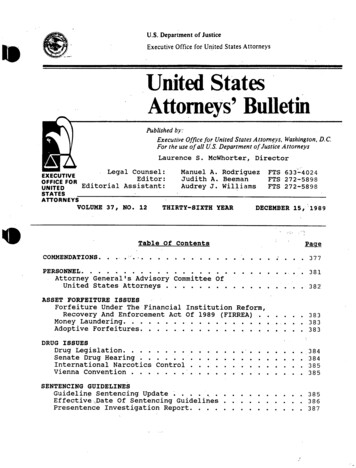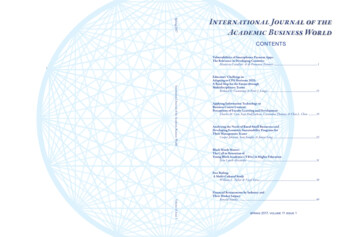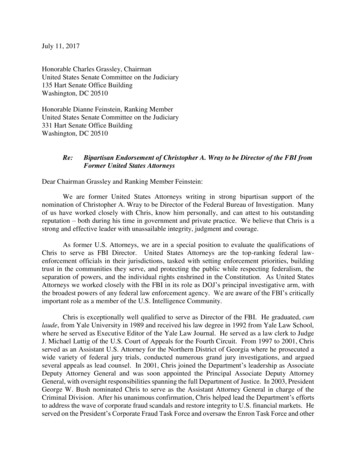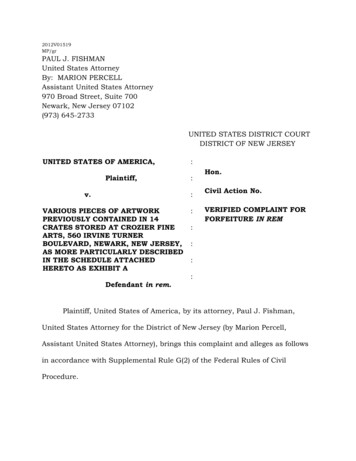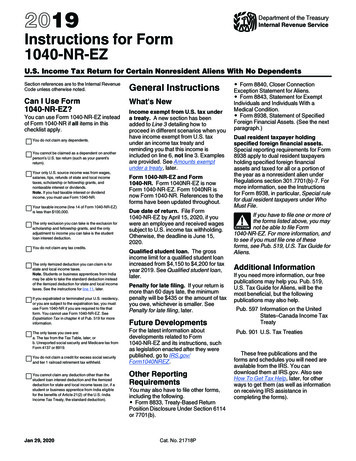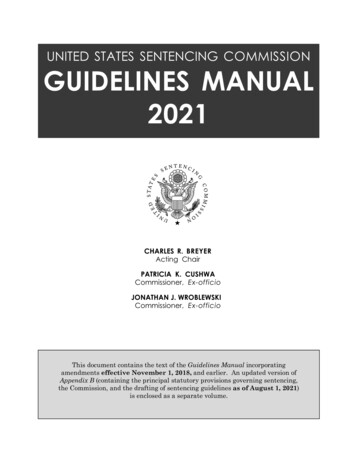
Transcription
UNITED STATES SENTENCING COMMISSIONGUIDELINES MANUAL2021CHARLES R. BREYERActing ChairPATRICIA K. CUSHWACommissioner, Ex-officioJONATHAN J. WROBLEWSKICommissioner, Ex-officioThis document contains the text of the Guidelines Manual incorporatingamendments effective November 1, 2018, and earlier. An updated version ofAppendix B (containing the principal statutory provisions governing sentencing,the Commission, and the drafting of sentencing guidelines as of August 1, 2021)is enclosed as a separate volume.
CITATION FORMRECOMMENDED CITATION FORMUnited States Sentencing Commission Guidelines, Policy Statements, and Commentary maybe cited as follows:I.Full citation formUnited States Sentencing Commission, Guidelines Manual, §3E1.1 (Nov. 2021)II.Abbreviated citation form[using USSG as the designated short form for United States Sentencing Guidelines] a guideline —USSG §2D1.1 a policy statement —USSG §6A1.1, p.s. commentary designated as an application note —USSG §2B1.1, comment. (n.1) commentary designated as background —USSG §2B1.1, comment. (backg’d.) commentary designated as an introduction —USSG Ch.3, Pt.D, intro. comment. commentary designated as a conclusion —USSG Ch.3, Pt.D, concl. comment. an appendix to the Guidelines Manual —USSG App. Cii Guidelines Manual (November 1, 2021)
TABLE OF CONTENTSTABLE OF CONTENTSCHAPTER ONEINTRODUCTION, AUTHORITY, AND GENERAL APPLICATION PRINCIPLES . 1Part1.2.3.A ― Introduction and Authority .1Original Introduction to the Guidelines Manual .1Continuing Evolution and Role of the Guidelines .13Authority .16Part B ― General Application Principles .17CHAPTER TWOOFFENSE CONDUCT . 50Part1.2.3.A ― Offenses Against the Person .50Homicide .50Assault .53Criminal Sexual Abuse and Offenses Related to Registrationas a Sex Offender .594. Kidnapping, Abduction, or Unlawful Restraint .725. Air Piracy and Offenses Against Mass Transportation Systems .756. Threatening or Harassing Communications, Hoaxes, Stalking,and Domestic Violence .77Part B ― Basic Economic Offenses .821. Theft, Embezzlement, Receipt of Stolen Property, PropertyDestruction, and Offenses Involving Fraud or Deceit .822. Burglary and Trespass .1113. Robbery, Extortion, and Blackmail .1154. Commercial Bribery and Kickbacks .1215. Counterfeiting and Infringement of Copyright or Trademark .1246. Motor Vehicle Ident ification Numbers .130Part C ― Offenses Involving Public Officials and Violations ofFederal Election Campaign Laws .131Part D ― Offenses Involving Drugs and Narco-Terrorism .1421. Unlawful Manufacturing, Importing, Exporting, Trafficking, orPossession; Continuing Criminal Enterprise .1422. Unlawful Possession .1893. Regulatory Violations .191Part1.2.3.4.5.E ― Offenses Involving Criminal Enterprises and Racketeering .193Racketeering .193Extortionate Extension of Credit .196Gambling .197Trafficking in Contraband Cigarettes and Smokeless Tobacco .199Labor Racketeering .199Guidelines Manual (November 1, 2021) iii
TABLE OF CONTENTSPart F ― [Deleted] .203Part G ― Offenses Involving Commercial Sex Acts, SexualExploitation of Minors, and Obscenity .2041. Promoting a Commercial Sex Act or Prohibited Sexual Conduct .2042. Sexual Exploitation of a Minor .2113. Obscenity .221Part1.2.3.4.H ― Offenses Involving Individual Rights .225Civil Rights .225Political Rights .227Privacy and Eavesdropping .228Peonage, Involuntary Servitude, Slave Trade, and Child Soldiers .231Part I ― [Not Used] .233Part J ― Offenses Involving the Administration Of Justice .234Part1.2.3.K ― Offenses Involving Public Safety .243Explosives and Arson .243Firearms .250Mailing Injurious Articles .263Part L ― Offenses Involving Immigration, Naturalization, andPassports .2651. Immigration .2652. Naturalization and Passports .273Part M ― Offenses Involving National Defense and Weapons of MassDestruction .2781. Treason .2782. Sabotage .2783. Espionage and Related Offenses .2794. Evasion of Military Service .2845. Prohibited Financial Transactions and Exports, and ProvidingMaterial Support to Designated Foreign Terrorist Organizations .2856. Nuclear, Biological, and Chemical Weapons and Materials, andOther Weapons of Mass Destruction .288Part N ― Offenses Involving Food, Drugs, Agricultural Products,Consumer Products, and Odometer Laws .2921. Tampering with Consumer Products .2922. Food, Drugs, Agricultural Products, and Consumer Products .2943. Odometer Laws and Regulations.295Part O ― [Not Used] .296Part P ― Offenses Involving Prisons and Correctional Facilities .297Part Q ― Offenses Involving the Environment .3011. Environment.3012. Conservation and Wildlife .308Part R ― Antitrust Offenses .311Part S ― Money Laundering and Monetary Transaction Reporting .315iv Guidelines Manual (November 1, 2021)
TABLE OF CONTENTSPart T ― Offenses Involving Taxation .3211. Income Taxes, Employment Taxes, Estate Taxes, Gift Taxes,and Excise Taxes (Other Than Alcohol, Tobacco, and CustomsTaxes) .3212. Alcohol and Tobacco Taxes .3303. Customs Taxes .3314. Tax Table .333Part U ― [Not Used] .334Part V ― [Not Used] .334Part W ― [Not Used] .334Part1.2.3.4.5.6.7.X ― Other Offenses .335Conspiracies, Attempts, Solicitations .335Aiding and Abetting .338Accessory After the Fact .338Misprision of Felony .339All Other Felony Offenses and Class A Misdemeanors .340Offenses Involving Use of a Minor in a Crime of Violence .342Offenses Involving Border Tunnels and Submersible andSemi-Submersible Vessels .343Part Y ― [Not Used] .344Part Z ― [Not Used] .344CHAPTER THREEADJUSTMENTS . 345Part A ― Victim-Related Adjustments .345Part B ― Role in the Offense .351Part C ― Obstruction and Related Adjustments .359Part D ― Multiple Counts .364Part E ― Acceptance of Responsibility .376CHAPTER FOURCRIMINAL HISTORY AND CRIMINAL LIVELIHOOD . 379Part A ― Criminal History .379Part B ― Career Offenders and Criminal Livelihood .395CHAPTER FIVEDETERMINING THE SENTENCE . 406Part A ― Sentencing Table .406Part B ― Probation .409Part C ― Imprisonment .418Guidelines Manual (November 1, 2021) v
TABLE OF CONTENTSPart D ― Supervised Release .424Part E ― Restitution, Fines, Assessments, Forfeitures .435Part F ― Sentencing Options .443Part G ― Implementing the Total Sentence of Imprisonment .449Part H ― Specific Offender Characteristics .458Part I ― [Not Used] .465Part J ― Relief From Disability .466Part1.2.3.K ― Departures .467Substantial Assistance to Authorities .467Other Grounds for Departure .468Early Disposition Programs .486CHAPTER SIXSENTENCING PROCEDURES, PLEA AGREEMENTS, AND CRIME VICTIMS’ RIGHTS . 487Part A ― Sentencing Procedures .487Part B ― Plea Agreements .491CHAPTER SEVENVIOLATIONS OF PROBATION AND SUPERVISED RELEASE . 496Part A ― Introduction to Chapter Seven .496Part B ― Probation and Supervised Release Violations .501CHAPTER EIGHTSENTENCING OF ORGANIZATIONS . 509Part A ― General Application Principles .510Part B ― Remedying Harm from Criminal Conduct, and EffectiveCompliance and Ethics Program .5141. Remedying Harm from Criminal Conduct .5142. Effective Compliance and Ethics Program .517Part1.2.3.4.C ― Fines .523Determining the Fine ― Criminal Purpose Organizations .523Determining the Fine ― Other Organizations .523Implementing the Sentence of a Fine .540Departures from the Guideline Fine Range .542Part D ― Organizational Probation .547Part E ― Special Assessments, Forfeitures, and Costs .551Part F ― Violations of Probation ― Organizations .553vi Guidelines Manual (November 1, 2021)
TABLE OF CONTENTSAPPENDIX A . 554INDEX TO GUIDELINES MANUAL . 579LIST OF DEPARTURE PROVISIONS . 597Guidelines Manual (November 1, 2021) vii
TABLE OF CONTENTSSUPPLEMENTARY VOLUMESAPPENDIX BSelected Sentencing StatutesAPPENDIX C (Volume I)Amendments to the Guidelines Manual(effective November 1, 1997, and earlier)APPENDIX C (Volume II)Amendments to the Guidelines Manual(effective November 1, 1998, through November 5, 2003)APPENDIX C (Volume III)Amendments to the Guidelines Manual(effective November 1, 2004, through November 1, 2011)SUPPLEMENT TO APPENDIX CAmendments to the Guidelines Manual(effective November 1, 2012, through November 1, 2018)viii Guidelines Manual (November 1, 2021)
Ch. 1 Pt. ACHAPTER ONEINTRODUCTION, AUTHORITY,AND GENERAL APPLICATION PRINCIPLESPART A ― INTRODUCTION AND AUTHORITYIntroductory CommentarySubparts 1 and 2 of this Part provide an introduction to the Guidelines Manual describing thehistorical development and evolution of the federal sentencing guidelines. Subpart 1 sets forth theoriginal introduction to the Guidelines Manual as it first appeared in 1987, with the inclusion ofamendments made occasionally thereto between 1987 and 2000. The original introduction, as soamended, explained a number of policy decisions made by the United States Sentencing Commission(“Commission”) when it promulgated the initial set of guidelines and therefore provides a useful reference for contextual and historical purposes. Subpart 2 further describes the evolution of the federalsentencing guidelines after the initial guidelines were promulgated.Subpart 3 of this Part states the authority of the Commission to promulgate federal sentencingguidelines, policy statements, and commentary.1.ORIGINAL INTRODUCTION TO THE GUIDELINES MANUALThe following provisions of this Subpart set forth the original introduction to this manual, effective November 1, 1987, and as amended through November 1, 2000:1.AuthorityThe United States Sentencing Commission (“Commission”) is an independentagency in the judicial branch composed of seven voting and two non-voting, ex officiomembers. Its principal purpose is to establish sentencing policies and practices for thefederal criminal justice system that will assure the ends of justice by promulgating detailed guidelines prescribing the appropriate sentences for offenders convicted of federalcrimes.The guidelines and policy statements promulgated by the Commission are issuedpursuant to Section 994(a) of Title 28, United States Code.2.The Statutory MissionThe Sentencing Reform Act of 1984 (Title II of the Comprehensive Crime ControlAct of 1984) provides for the development of guidelines that will further the basic purGuidelines Manual (November 1, 2021) 1
Ch. 1 Pt. Aposes of criminal punishment: deterrence, incapacitation, just punishment, and rehabilitation. The Act delegates broad authority to the Commission to review and rationalizethe federal sentencing process.The Act contains detailed instructions as to how this determination should bemade, the most important of which directs the Commission to create categories of offensebehavior and offender characteristics. An offense behavior category might consist, forexample, of “bank robbery/committed with a gun/ 2500 taken.” An offender characteristic category might be “offender with one prior conviction not resulting in imprisonment.” The Commission is required to prescribe guideline ranges that specify an appropriate sentence for each class of convicted persons determined by coordinating the offense behavior categories with the offender characteristic categories. Where the guidelines call for imprisonment, the range must be narrow: the maximum of the range cannot exceed the minimum by more than the greater of 25 percent or six months. 28 U.S.C.§ 994(b)(2).Pursuant to the Act, the sentencing court must select a sentence from within theguideline range. If, however, a particular case presents atypical features, the Act allowsthe court to depart from the guidelines and sentence outside the prescribed range. Inthat case, the court must specify reasons for departure. 18 U.S.C. § 3553(b). If the courtsentences within the guideline range, an appellate court may review the sentence todetermine whether the guidelines were correctly applied. If the court departs from theguideline range, an appellate court may review the reasonableness of the departure.18 U.S.C. § 3742. The Act also abolishes parole, and substantially reduces and restructures good behavior adjustments.The Commission’s initial guidelines were submitted to Congress on April 13, 1987.After the prescribed period of Congressional review, the guidelines took effect on November 1, 1987, and apply to all offenses committed on or after that date. The Commission has the authority to submit guideline amendments each year to Congress betweenthe beginning of a regular Congressional session and May 1. Such amendments automatically take effect 180 days after submission unless a law is enacted to the contrary.28 U.S.C. § 994(p).The initial sentencing guidelines and policy statements were developed after extensive hearings, deliberation, and consideration of substantial public comment. TheCommission emphasizes, however, that it views the guideline-writing process as evolutionary. It expects, and the governing statute anticipates, that continuing research, experience, and analysis will result in modifications and revisions to the guidelinesthrough submission of amendments to Congress. To this end, the Commission is established as a permanent agency to monitor sentencing practices in the federal courts.3.The Basic Approach (Policy Statement)To understand the guidelines and their underlying rationale, it is important to focus on the three objectives that Congress sought to achieve in enacting the SentencingReform Act of 1984. The Act’s basic objective was to enhance the ability of the criminal2 Guidelines Manual (November 1, 2021)
Ch. 1 Pt. Ajustice system to combat crime through an effective, fair sentencing system. To achievethis end, Congress first sought honesty in sentencing. It sought to avoid the confusionand implicit deception that arose out of the pre-guidelines sentencing system which required the court to impose an indeterminate sentence of imprisonment and empoweredthe parole commission to determine how much of the sentence an offender actuallywould serve in prison. This practice usually resulted in a substantial reduction in theeffective length of the sentence imposed, with defendants often serving only about onethird of the sentence imposed by the court.Second, Congress sought reasonable uniformity in sentencing by narrowing thewide disparity in sentences imposed for similar criminal offenses committed by similaroffenders. Third, Congress sought proportionality in sentencing through a system thatimposes appropriately different sentences for criminal conduct of differing severity.Honesty is easy to achieve: the abolition of parole makes the sentence imposed bythe court the sentence the offender will serve, less approximately fifteen percent for goodbehavior. There is a tension, however, between the mandate of uniformity and the mandate of proportionality. Simple uniformity — sentencing every offender to five years —destroys proportionality. Having only a few simple categories of crimes would make theguidelines uniform and easy to administer, but might lump together offenses that aredifferent in important respects. For example, a single category for robbery that includedarmed and unarmed robberies, robberies with and without injuries, robberies of a fewdollars and robberies of millions, would be far too broad.A sentencing system tailored to fit every conceivable wrinkle of each case wouldquickly become unworkable and seriously compromise the certainty of punishment andits deterrent effect. For example: a bank robber with (or without) a gun, which the robberkept hidden (or brandished), might have frightened (or merely warned), injured seriously (or less seriously), tied up (or simply pushed) a guard, teller, or customer, at night(or at noon), in an effort to obtain money for other crimes (or for other purposes), in thecompany of a few (or many) other robbers, for the first (or fourth) time.The list of potentially relevant features of criminal behavior is long; the fact thatthey can occur in multiple combinations means that the list of possible permutations offactors is virtually endless. The appropriate relationships among these different factorsare exceedingly difficult to establish, for they are often context specific. Sentencingcourts do not treat the occurrence of a simple bruise identically in all cases, irrespectiveof whether that bruise occurred in the context of a bank robbery or in the context of abreach of peace. This is so, in part, because the risk that such a harm will occur differsdepending on the underlying offense with which it is connected; and also because, inpart, the relationship between punishment and multiple harms is not simply additive.The relation varies depending on how much other harm has occurred. Thus, it wouldnot be proper to assign points for each kind of harm and simply add them up, irrespective of context and total amounts.The larger the number of subcategories of offense and offender characteristics included in the guidelines, the greater the complexity and the less workable the system.Moreover, complex combinations of offense and offender characteristics would apply andinteract in unforeseen ways to unforeseen situations, thus failing to cure the unfairnessGuidelines Manual (November 1, 2021) 3
Ch. 1 Pt. Aof a simple, broad category system. Finally, and perhaps most importantly, probationofficers and courts, in applying a complex system having numerous subcategories, wouldbe required to make a host of decisions regarding whether the underlying facts weresufficient to bring the case within a particular subcategory. The greater the number ofdecisions required and the greater their complexity, the greater the risk that differentcourts would apply the guidelines differently to situations that, in fact, are similar,thereby reintroducing the very disparity that the guidelines were designed to reduce.In view of the arguments, it would have been tempting to retreat to the simple,broad category approach and to grant courts the discretion to select the proper pointalong a broad sentencing range. Granting such broad discretion, however, would haverisked correspondingly broad disparity in sentencing, for different courts may exercisetheir discretionary powers in different ways. Such an approach would have risked a return to the wide disparity that Congress established the Commission to reduce andwould have been contrary to the Commission’s mandate set forth in the Sentencing Reform Act of 1984.In the end, there was no completely satisfying solution to this problem. The Commission had to balance the comparative virtues and vices of broad, simple categorizationand detailed, complex subcategorization, and within the constraints established by thatbalance, minimize the discretionary powers of the sentencing court. Any system will, toa degree, enjoy the benefits and suffer from the drawbacks of each approach.A philosophical problem arose when the Commission attempted to reconcile thediffering perceptions of the purposes of criminal punishment. Most observers of thecriminal law agree that the ultimate aim of the law itself, and of punishment in particular, is the control of crime. Beyond this point, however, the consensus seems to breakdown. Some argue that appropriate punishment should be defined primarily on the basis of the principle of “just deserts.” Under this principle, punishment should be scaledto the offender’s culpability and the resulting harms. Others argue that punishmentshould be imposed primarily on the basis of practical “crime control” considerations.This theory calls for sentences that most effectively lessen the likelihood of future crime,either by deterring others or incapacitating the defendant.Adherents of each of these points of view urged the Commission to choose betweenthem and accord one p
Guidelines Manual (November 1, 2021) RECOMMENDED CITATION FORM. United States Sentencing Commission Guidelines, Policy Statements, and Commentary may be cited as follows: I. Full citation form. United States Sentencing Commission, Guidelines Manual, §3E1.1 (Nov. 2021) II. Abbreviated citation form




